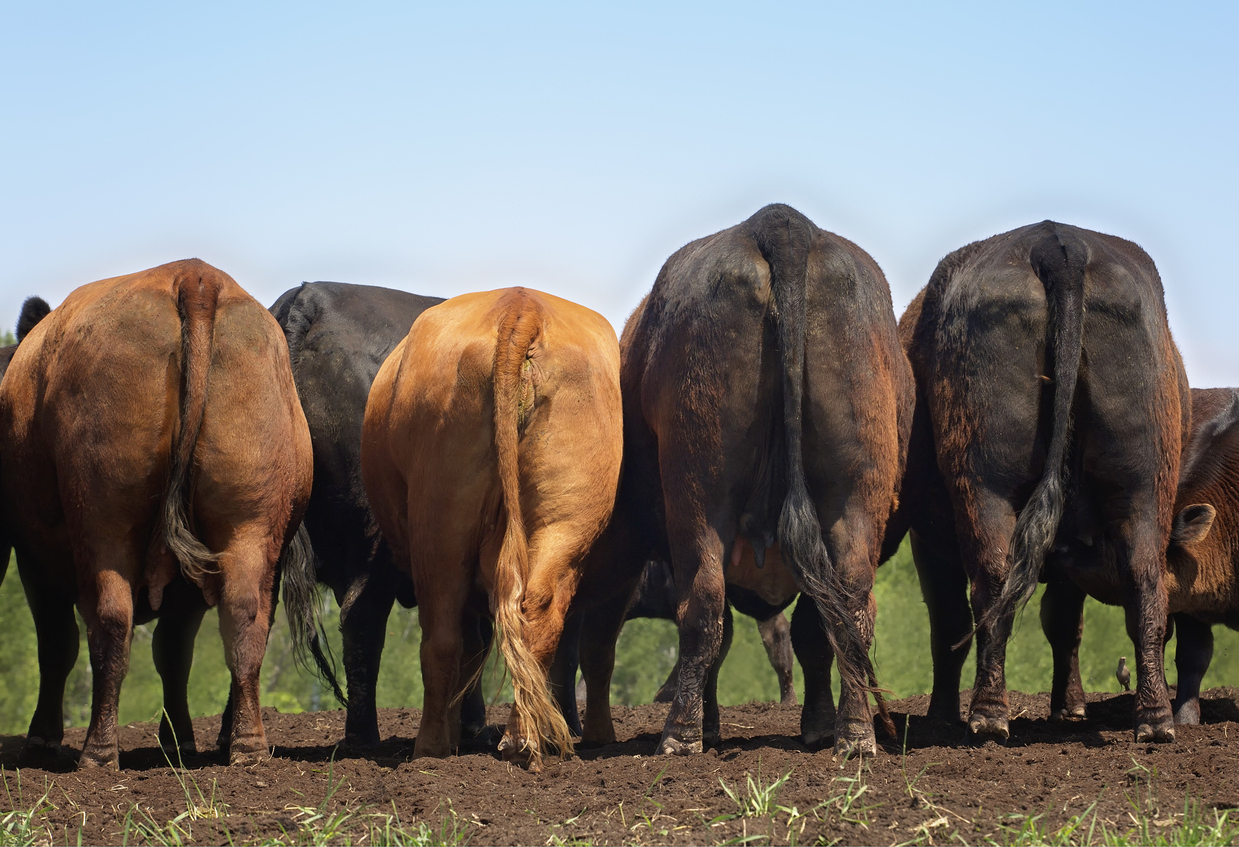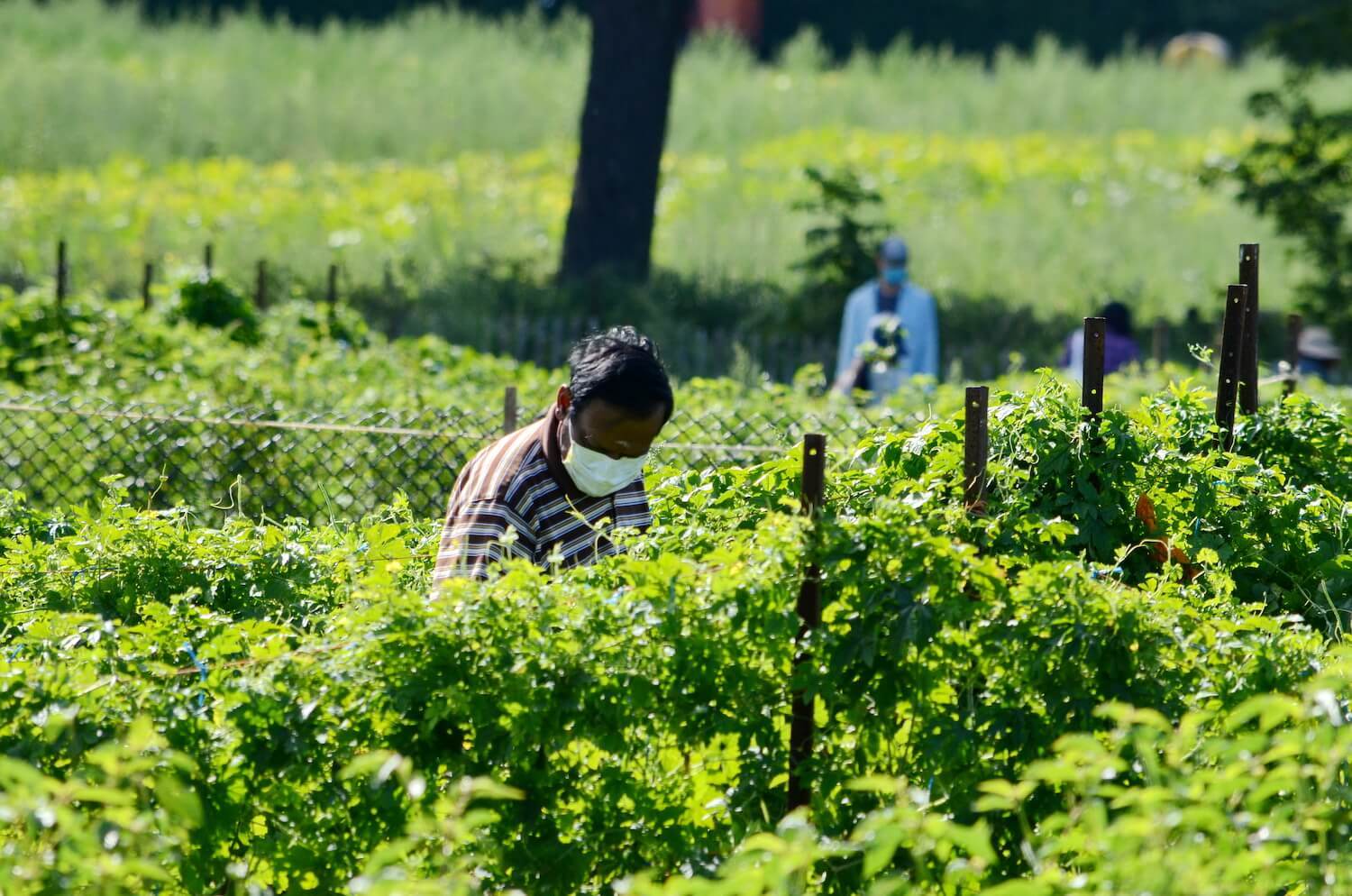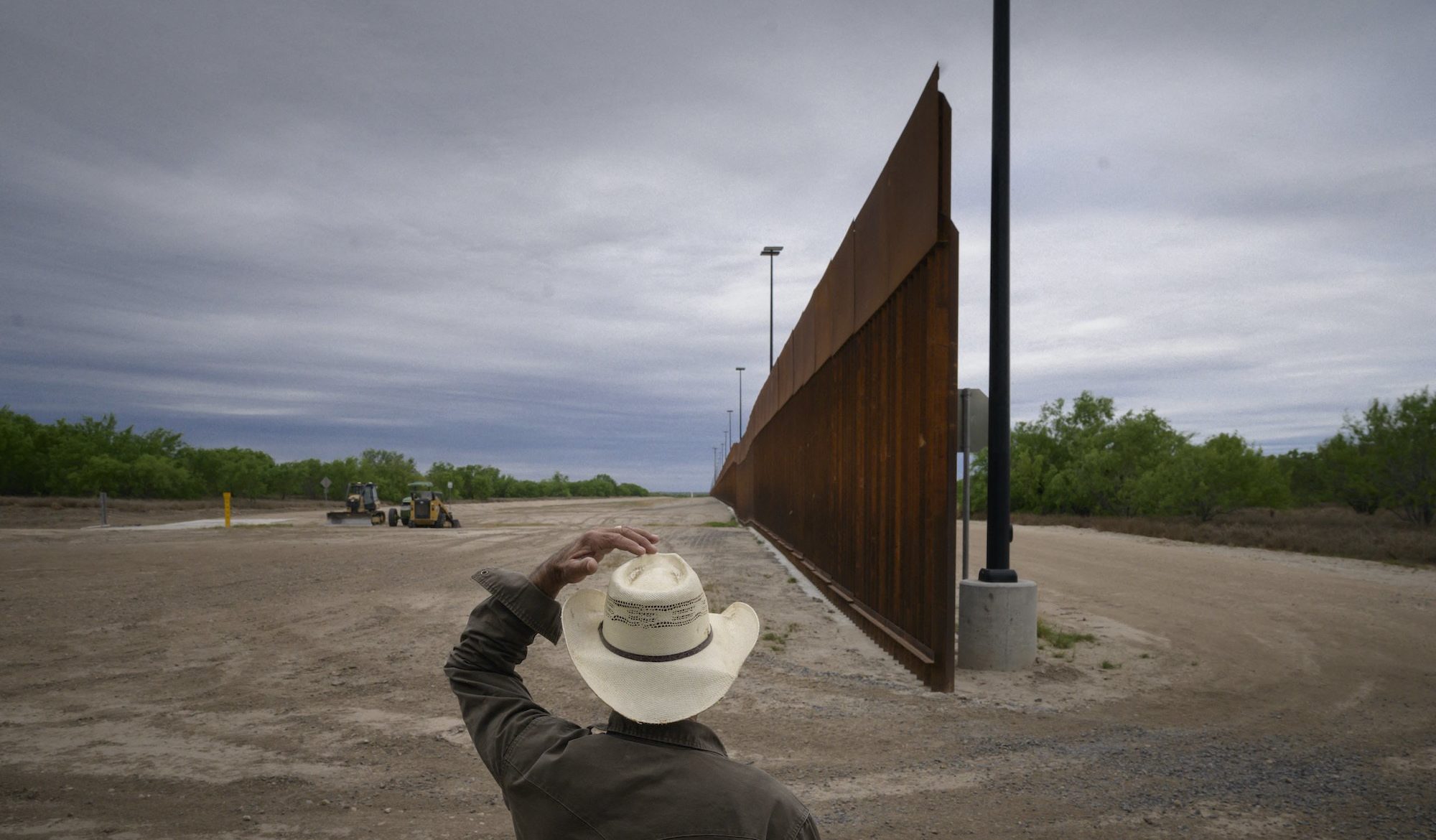
ED JONES/AFP via Getty Images
The state’s agriculture community is caught in a push and pull between its need for workers and its desire to criminalize undocumented immigrants.
For weeks, Claudia Muñoz fielded panicked phone calls from attorneys and advocates about Operation Lone Star, Texas Governor Greg Abbott’s chaotic new border security initiative that allows law enforcement officers to arrest and jail migrants on state criminal charges, like trespassing.
Pictured above: On March 28, 2021, ranch owner Tony Sandoval stands before a portion of the unfinished border wall that former U..S president Donald Trump tried to build, near the southern Texas border city of Roma.
Muñoz, co-executive director of the Austin-based advocacy organization Grassroots Leadership, decided to drive south to Val Verde County to see how Abbott’s initiative was playing out on the ground. But first, she attended a July 28 town hall for ranchers organized by La Salle County Sheriff, Anthony Zertuche.
“I get there and it’s mostly older, white ranchers in the crowd and honestly, it felt hard to sit through,” said Muñoz, a formerly undocumented immigrant. “They called immigrants ‘illegals,’ compared them to animals; said they were from a different breed; and they said [migrants] were bringing Covid into the country. But the worst thing was when [officials] started explaining how to file charges on people.”
To carry out Operation Lone Star, Abbott has deployed extraordinary resources to counties near the southern border—including about a quarter of the state’s police force and members of the National Guard, which forced the closure of an El Paso food bank where the guard members were deployed. As of mid-August, hundreds of migrants have already been arrested in Val Verde County and nearby Kinney County, The Texas Tribune reports. Their hearings have been broadcast live on Val Verde County’s YouTube channel.
But as La Salle County’s town meeting makes clear, Operation Lone Star also relies on the participation of ranchers and farmers, who are being instructed by law enforcement and state officials to file police reports about migrants found on their property. This organizing effort all but ensures that they, too, are ensnared in Abbott’s dragnet.
“I realized Greg Abbott is organizing law enforcement for Operation Lone Star, and that law enforcement is organizing ranchers to file charges on migrants.”
Prior to the pandemic and Operation Lone Star, migrants apprehended while crossing the border without authorization would be turned over to federal immigration authorities. Those who feared persecution in their home countries would be ushered through the asylum process and everyone else would eventually be deported. But under Operation Lone Star, which launched in March, unaccompanied migrants alleged to have been on private property while attempting to enter the country are now being arrested for the state crime of trespassing. The arrestees (for various reasons it’s almost exclusively men), some of whom are indeed asylum seekers or are migrating with family, are then jailed at the Briscoe Unit, an unprecedented Texas-run jail specifically for migrants who’ve been charged with this low-level crime. (Abbott cleared Briscoe of most incarcerated people in June to make room for immigrants.)
Muñoz has been in the trenches of the immigrants’ rights movement for more than a decade, but said she was shocked by her trip. It wasn’t just that the counties near the border looked like “occupied territory,” she said, overtaken by state troopers from across Texas and from as far away as Florida and Iowa. It was the realization she had while sitting at the town hall, surrounded by ranchers.
“I realized Greg Abbott is organizing law enforcement for Operation Lone Star, and that law enforcement is organizing ranchers to file charges on [migrants],” Muñoz said.
“The fastest way to send them back home”
At the La Salle County town meeting that The Counter viewed on video, one of the most animated speakers was Michael Blair, district director for a new Republican congressman, Tony Gonzales. Endorsed by former President Donald Trump, Gonzales has made border security a primary focus of his office. As his representative, Blair admonished the Biden administration and gave ranchers play-by-play instructions for filing charges on immigrants.
“If you have someone who does damage to your property, file a police report because the fastest way for us—say these people get caught and they get deported—the fastest way to send them back home when they try to cross over again is for them to have a criminal record. Because if they have a criminal record, they’re going home like that,” Blair said, snapping his fingers.
Blair also instructed ranchers to keep records if someone comes through their fence, for example, or cuts fencing.
“Document it; document the date and time and if you have a copy of the police report, keep it,” Blair said. “I don’t have news for you right now, but this is something that could potentially ultimately be reimbursed. It’s good documentation to have for the future because I know that our governor has asked counties to keep track of their costs as it relates to the border crisis… In our office, this is not an issue we’re going to let go. This is something we’re going to remember when we’re back in the majority.”
A bipartisan federal bill was introduced in August by Texas Republican Congressmen August Pfluger and Tony Gonzales, and Democrats Vicente Gonzalez and Henry Cuellar that would reimburse farmers and ranchers for “migration property damage.” The proposal said it would reimburse agricultural producers for damages “stemming from mass migration”—including livestock loss, crop loss and damage, damage to perimeter fences, damage to physical structures, and property loss/damage—by repurposing “unobligated monies” from the American Rescue Plan, the Biden administration’s $1.9 trillion Covid rescue package designed to facilitate the country’s recovery.
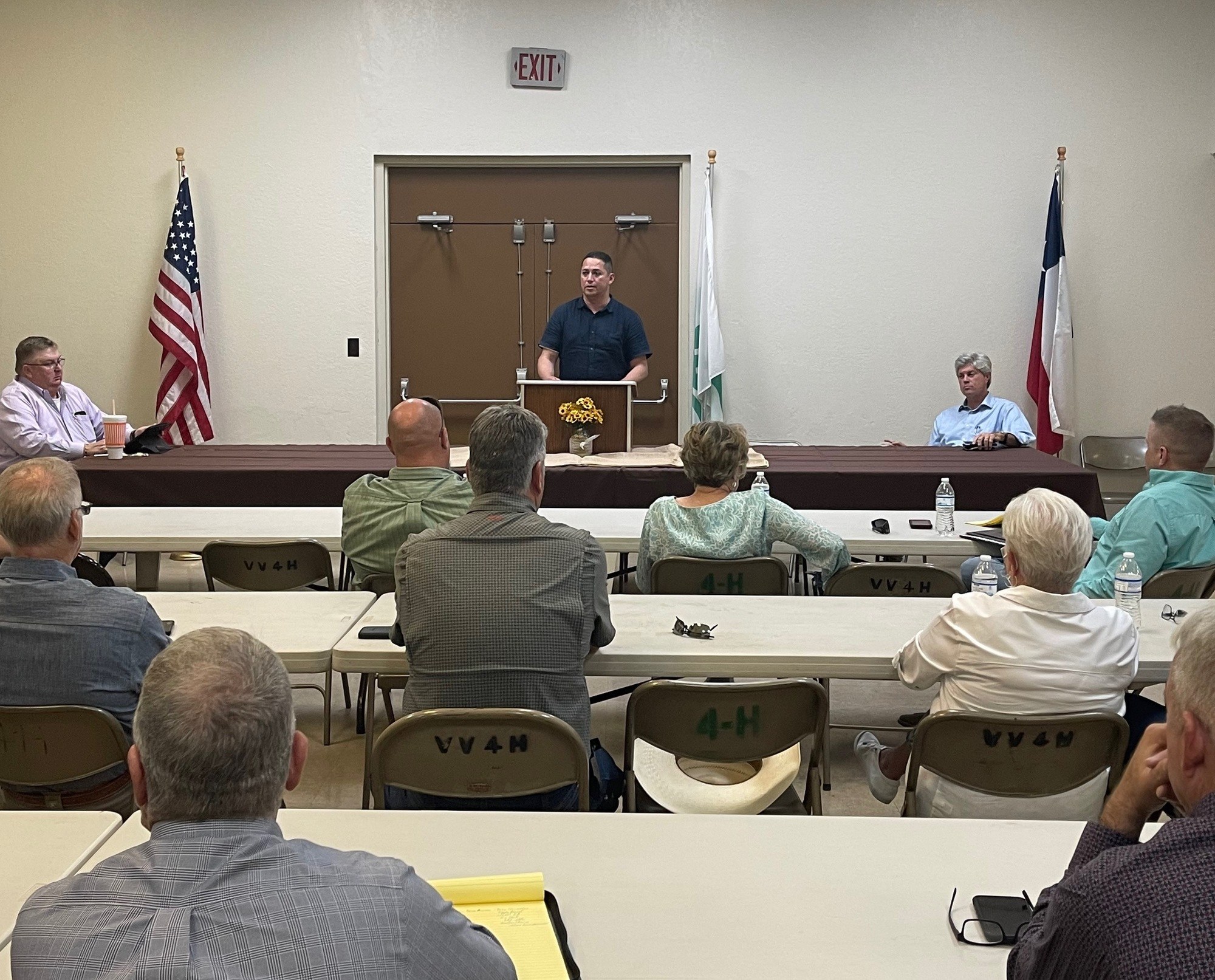
Texas Republican Congressman Tony Gonzales speaks at a roundtable for ranchers and farmers in partnership with Texas Farm Bureau and American Farm Bureau.
Courtesy of Congressman Tony Gonzales
The bill is supported by the National Cattlemen’s Beef Association and the Texas Farm Bureau (TFB), which has been one of its most vocal proponents. TFB’s president, Russell Boening, said in a statement that the organization has been listening to the concerns of “many farmers and ranchers who have experienced significant property damages due to the influx of illegal immigration.” Shortly after introducing the bill, Gonzales spoke at a roundtable for ranchers and farmers with Boening and American Farm Bureau president Zippy Duvall, who also toured the border with Gonzales.
A few months after Abbott launched Operation Lone Star, TFB, which donated $85,000 to the governor’s campaign during the 2018 Texas gubernatorial election, sent a letter to the Department of Homeland Security (DHS), the Department of Agriculture, and the Department of the Interior, parroting much of Abbott’s language regarding the “surge on the border.”
In reference to the initiative, Abbott said during a press conference in April that because the federal government “is failing to act,” Texas is “stepping up to secure the border and keep our communities safe.” In TFB’s June letter, which was signed by every chapter in the country and the American Farm Bureau Federation, the organization said that local and state border security resources “have been exhausted, leaving little help for farmers and ranchers.”
“We respectfully request federal authorities work promptly to provide additional resources and enforce legal immigration to secure U.S. borders,” the letter read.
“We know that migration is on the rise and maybe there is some property damage happening, but this strikes me as manufactured hysteria.”
Attorney Barbara Hines, founder of the University of Texas Law School Immigration Clinic, has practiced immigration law since 1975. Some of her earliest cases were related to ranchers who called Border Patrol on their own undocumented workers before pay day so as to avoid paying them. Hines told The Counter that the timing of TFB’s letter and its larger “Border Crisis Impacts” campaign—the rhetoric and timing of which overlaps with Operation Lone Star—is “interesting.”
“We know that migration is on the rise and maybe there is some property damage happening, but this strikes me as manufactured hysteria,” Hines said. “Something about property gets said in the media and it gets repeated over and over again so that we’re focused on broken fences instead of people dying in the desert and children and families seeking asylum. Greg Abbott is anti-immigrant and turning the focus to the property rights of ranchers and farmers says more about the dark creativity of his agenda than anything else.”
According to data released in August, CBP carried out 212,000 migrant apprehensions in July, which included approximately 110,000 single adult migrants, 83,000 migrant families, and 19,000 unaccompanied children. Aaron Reichlin-Melnick, policy counsel at the American Immigration Council, told The Counter that the country is in an “odd situation right now” because the number of current border crossings is in no way unprecedented on a national level, but the locations at which people are crossing in large numbers are different now than where they were crossing decades ago.
“Twenty years ago, the primary crossing points were in California and Arizona. There were certainly large numbers of apprehensions in Texas, but we have now blown past those numbers and we are seeing record numbers of apprehensions along the Texas-Mexico border,” Reichlin-Melnick said. “So, it’s simultaneously true that crossings are well within historical norms, and also unprecedented in that specific area. It is complicated and ranchers are likely seeing more people, but to me the blame should be more on those who built the border wall that forced people further out and not the migrants themselves who are fleeing to seek safety.”
Federal policies shaping the border
TFB’s “Border Crisis Impacts” campaign features links to “governmental resources” like CPB press releases about border apprehensions, as well as a video Kinney County Sheriff Brad Coe made for TFB. The sheriff, who is a regular on Fox News and attends Abbott’s border security briefings, said Kinney County is “under siege” by migrants and that his deputies are “slow” getting to ranchers who report property damage because deputies are “constantly” helping Border Patrol and state troopers with migration-related traffic stops, presumably as part of Operation Lone Star.
The campaign also features videos from long-time ranchers like Stephanie Crisp-Canales, who said her family has always had “illegals cross over,” but that conditions are getting “worse and worse and worse.” As an example, Crisp-Canales said that her ranch sees multiple “bailouts” a day—a reference to when vehicles full of migrants driven by “coyotes,” usually men paid to bring people to the U.S., are chased by law enforcement onto a rancher’s property, leading to damage to the premises. Crispin-Canales said these bailouts are also happening in the middle of small Texas towns, potentially putting residents in danger.
The shortage of local deputies on the ground as described by Coe, and the property damage described by Crisp-Canales and other ranchers result from a style of policing that local law enforcement officials are choosing to engage in—even though immigration enforcement is squarely the responsibility of federal agencies like CBP. And as Reichlin-Melnick suggested, federal immigration policies have shaped conditions at the border.
In a series of reports published over the course of five years, the southern Arizona-based organizations No More Deaths and La Coalición de Derechos Humanos have catalogued the specific Border Patrol policies and tactics that they say have fueled the deaths and disappearances of thousands of migrants in the borderlands. The first report, released in 2016, detailed the 1994 policy “Prevention Through Deterrence,” in which the United States militarized urban border areas in an effort to steer migrants away from ports of entry and into more remote and hazardous regions. This is why migrants now end up traversing land privately owned by ranchers, and why unknown numbers of migrants die each year in the borderlands.
A bipartisan federal bill would reimburse agricultural producers for damages “stemming from mass migration” by repurposing “unobligated monies” from the American Rescue Plan.
Vicki Gaubeca is the director of the Southern Border Communities Coalition, which brings together 60 organizations from San Diego, California, to Brownsville, Texas, to advocate for border enforcement policies and practices that respect human dignity and rights. Guabeca says there are real reasons for farmers and ranchers to be angry, but that their anger is misplaced.
“A lot of enforcement—including the building of a border wall, the technologies and tactics used, the number of Border Patrol agents—all that stuff has created more environmental harm than immigration,” Guabeca said. “Ever since the Secure Fence Act in 2006, farmers and ranchers in Texas have been losing their land to the border wall. Texas geography means that the border is the Rio Grande River and because you can’t build a physical barrier on the side of the river without erosion, the border wall is north of the actual river and it cuts off farmers and ranchers from their own land. It’s the enforcement tactics that have been most harmful to farmers and ranchers; not the immigrants themselves.”
The Texas Farm Bureau’s June letter of concern to Homeland Security officials wasn’t entirely unprecedented. Under very different circumstances, the non-profit organization R-CALF USA, which represents thousands of ranchers nationwide, sent a letter to DHS in 2010 after one of its members, 58-year-old Rob Krentz, head of one of the oldest ranch families in southeast Arizona, was killed.
“Though this incident is under investigation, it is clear that the safety and security of our U.S. ranch families along the U.S.-Mexico border are at risk, and much more needs to be done to protect their lives and property,” R-CALF’s letter said. “Among the most vital roles of government is the protection of its citizens from foreign threats. The threats associated with illegal border crossing and drug trafficking at the U.S.-Mexico border have persisted for far too long. The ranch families along this border who continually face this threat deserve much more from their government.”
“It’s the enforcement tactics that have been most harmful to farmers and ranchers; not the immigrants themselves.”
Krentz’s family alleged that the rancher was killed by a migrant who was crossing his property, though 30 people on both sides of the border were considered persons of interest in the case. After it was revealed that U.S. citizens were also under investigation, Krentz’s wife went to extraordinary lengths to prohibit officials from releasing information regarding her husband’s death. The rancher’s murder was never solved, but it became the impetus for the “show me your papers” law that allowed police to profile people they suspected were undocumented immigrants, cementing Arizona’s reputation as one of the toughest border states.
R-CALF’s CEO, Bill Bullard, told The Counter that Krentz’s murder was the organization’s “first point of awareness” related to border issues and that, among ranchers in that community, it “radically changed” their sense of safety.
But at R-CALF’s annual convention held in South Dakota in mid-August, Bullard said he “did not hear a single word” about migration property damage from the approximately 400 ranchers who attended the event.
In fact, one of the event’s speakers, Greg Owens, owner of the New York-based flatware manufacturer Liberty Tabletop, made a point of saying that if the U.S. wants to have a manufacturing renaissance, it needs to change immigration policies to attract more skilled workers.
“He suggested we might call this Ellis Island 2.0,” Bullard relayed.
Still, organizations like the Arizona Cattle Grower’s Association, a new R-CALF affiliate, take a strong stance on border issues. The group has an 18-point “Restore Our Border” plan, and says “current security measures and law enforcement assets deployed in Arizona on the U.S.-Mexico border are not sufficient to secure the border.”
In January, the American Immigration Council published a report on the cost of immigration enforcement and border security. It showed that since the creation of DHS in 2003, the federal government has spent an estimated $333 billion on the agencies that carry out immigration enforcement. It appears to have done little to reduce the number of economic migrants and asylum seekers fleeing for their lives.
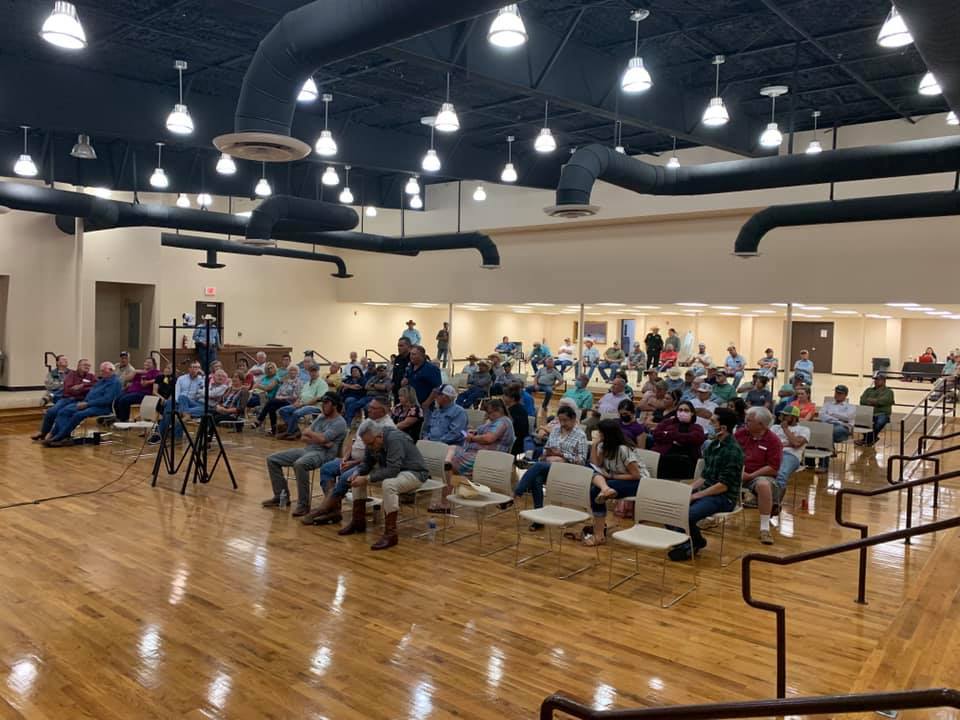
Ranchers and other landowners present at the July 28 town hall organized by La Salle County Sheriff, Anthony Zertuche.
La Salle County/Facebook
‘No basis in reality’
Before TFB rallied support for what Gaubeca called its “fearmongering letter” to DHS, the organization weighed in on immigration in other ways. Though immigration isn’t one of its stated priority issues, TFB has advocated for more “comprehensive and flexible agricultural guest worker reform,” for example. Even in its Border Crisis Impacts campaign, TFB is careful to differentiate between “lawful migration” and “illegal immigration,” throwing its support behind the former. In agriculture, Hines and other advocates say this distinction is disingenuous.
“Most of the people that work on ranches and farms are not ‘legal’ and never will be,” Hines said, noting that when the U.S. negotiated a new Bracero Program agreement in the 1950s that made it a felony to harbor or conceal an “illegal entrant,” Texas ranchers and farmers advocated for the Texas Proviso, which ensured that employing undocumented migrants would not constitute “harboring or concealing” them. “That’s how crucial undocumented workers were to them,” Hines said.
The Texas Proviso recently came up in a landmark court decision that, in part, acknowledged the role the agricultural lobby has played in racist immigration policies. A federal judge in Nevada ruled in August that Section 1326 of the Immigration and Nationality Act, which makes it a felony for an individual who has been deported to re-enter the United States, is unconstitutional.
Texas Farm Bureau is careful to differentiate between “lawful migration” and “illegal immigration,” throwing its support behind the former. In agriculture, advocates say this distinction is disingenuous.
Gustavo Carrillo-Lopez, the defendant in the criminal case, was first charged under Section 1326 by the Trump administration after he was found in the U.S. after being previously deported. He filed a motion asking to dismiss the indictment against him, arguing that Section 1326 was a violation of the Fifth Amendment’s equal protection guarantee. The crux of his argument was that the law that he was charged with that criminalized re-entry was specifically, unconstitutionally enacted to target Latinos. Chief U.S. District Judge Miranda Du agreed and dismissed the indictment, writing in the ruling that the defendant “established that Section 1326 was enacted with a discriminatory purpose and that the law has a disparate impact on Latinx persons, and the government fails to show that Section 1326 would have been enacted absent racial animus.”
When the Act took effect in 1952, the government began to focus on unauthorized immigration. A presidential commission likened migration to an “invasion.” In now-familiar language, the attorney general at the time toured the U.S.-Mexico border and called the scale of migration “shocking” and said it “constituted one of the nation’s gravest law enforcement problems.” But the U.S. had an urgent need for Mexican labor. This led to the creation of the Bracero Program, which gave Mexican laborers permission to work in the United States. At the same time, the U.S. government launched “Operation Wetback,” the mass deportation of Mexicans in the United States—including those with authorization to be in the country. Rather than focus on reforming the immigration system, the U.S. has historically chosen to focus on enforcement, leading to a near-constant push and pull between its need for workers and its desire to criminalize undocumented immigrants.
San Diego State University Professor Benjamin Gonzalez O’Brien, who provided expert testimony in the case, explained that much of the debate around the act was about limiting the number of Mexican immigrants and trafficking of undocumented Mexican immigrants into the U.S., while also allowing for the Texas Proviso that gave employers a legal loophole.
“Fundamentally, this does feel like a misinformation campaign with no basis in reality that is specifically designed to create fear about immigrants.”
Migrant workers remain crucial to ranchers and farmers in the borderlands. Gaubeca said that of the 1.2 million undocumented farmworkers in the U.S., approximately half are located in the border states of California, Arizona, New Mexico, and Texas.
“The letter from [Texas Farm Bureau] seems like a racist attempt to vilify immigrants without really acknowledging how much these ranchers and farmers rely on these same people for work,” Gaubeca said. “Fundamentally, this does feel like a misinformation campaign with no basis in reality that is specifically designed to create fear about immigrants.”
‘You can see the fear in their eyes’
So far, the data on “migration property damage” is slim and mostly anecdotal. When asked for reports, statistics, or other data used to inform its Border Crisis Impacts campaign and allegations of widespread property damage, TFB told The Counter it relied on “personal accounts” from farmers and ranchers and “various media reports.” The offices of the Texas congressmen who introduced the bill to reimburse ranchers and farmers for migration-related property damage also failed to provide any relevant data on the scope of the problem.
On May 31, when Abbott issued a disaster declaration for dozens of Texas counties based on an increase in migration at the Texas-Mexico border, it allowed the Texas Department for Emergency Management (TDEM) to activate an Individual State of Texas Assessment Tool (iSTAT), most commonly used to assess damage from severe weather events. On July 1, Abbott urged Texas landowners in border communities to complete the state’s Self Reporting Damage Survey to help “identify damages suffered by landowners along the border and inform the state’s ongoing efforts to secure the border.”
According to TDEM, iSTAT allows property owners to submit information about the extent of damages due to increased migration, provide a physical location of the damage, and submit photos.
“The information provided helps emergency management officials across the state gain an understanding of damages that have occurred during a declared disaster, and if further information is warranted TDEM has preliminary damage assessment teams that will visit the property with the property owner to assess the documented damages,” the agency said in a statement.
“I want people to understand this isn’t just about migrants unfairly being criminalized; this is about a horrible criminal justice system in Texas that is being weaponized against yet another group of people.”
The damage survey for the “border crisis” is available online, though the boilerplate language intended for extreme weather events doesn’t really apply to ranchers who say they’re experiencing border enforcement-related property damage. The survey asks landowners if they are able to live in their home after “the disaster impacts,” for example, and requests information about any utility outages in the area.
TDEM told The Counter it has received just 36 responses to the survey so far. Because the survey only assesses the extent of reported damages, the agency said it could not share any data that would illustrate the related economic impact.
It’s unclear what effect the Nevada decision will have on Texas, but as of right now there is no end in sight for Operation Lone Star. HB9, which is currently in the appropriations committee, would increase border spending for the operation by $1.77 billion dollars. Jay Root, an investigative reporter for The Houston Chronicle, found that Val Verde County attorney David Martinez is now allowing state troopers to charge migrants with criminal trespassing without even requiring a signature from the landowner on the complaint. More alarming, in video footage released by the Kinney County Sheriff’s Office, a large group of migrants arrested under Operation Lone Star appear at a mass hearing in a parking lot, a scene reminiscent of Operation Streamline, which criminally prosecuted migrants for entering the U.S. and led to assembly-line mass hearings that violated due process.
According to Muñoz, the men charged under Operation Lone Star are being given bonds as high as $10,000 for the misdemeanor offense of trespassing on private property.
“I want people to understand this isn’t just about migrants unfairly being criminalized; this is about a horrible criminal justice system in Texas that is being weaponized against yet another group of people,” Muñoz said. “Migrants come here expecting to be apprehended by immigration, but they are very confused about why they are apprehended by law enforcement and have to go to criminal court. There is so much confusion and you can see the fear in their eyes during hearings. They are alone in this country in front of a judge and it’s terrifying.”
Correction: An earlier version of this story identified Tony Gonzales as a state representative. He is a U.S. congressman. Additionally, Democratic Rep. Vicente Gonzales was initially identified as a Republican.

